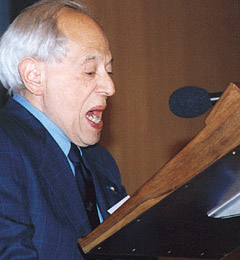The international “Niels Bohr and the Evolution of Physics in the 20th Century” meeting earlier this year provided the opportunity to reassess the evolutional impact of Bohr’s “Lebenswerk”.
Niels Bohr (1885-1962) did not coincide entirely with the 20th century, but was nevertheless one of its great motive powers. The meeting, organized by the Niels Bohr Institute in Copenhagen, brought together about 200 eminent physicists at UNESCO’s headquarters in Paris from 2729 May to consider his scientific legacy.

After presenting the wide variety of Bohr’s seminal ideas and paradigms, speakers turned to the present vitality of these concepts at the frontiers of modern physics, emphasizing also the growing symbioses between physics and biology, and between physics and information theory.
The opening talks on Bohr, by biographer Abraham Pais and by Ove Nathan of the Niels Bohr Institute, recalled the deep involvement of science with the everlasting challenge to express ourselves in a way which is both philosophically correct and reflects profound personal integrity.
Examples are the contest early this century between Bohr and Einstein on the interpretation and understanding of the quantum mechanical concepts of measurement and evidence; and the subsequent contests between Bohr and, in turn, Roosevelt, Churchill (who suggested keeping Bohr under house arrest), and later the UN, in the struggle to prevent world politics degenerating into an atomic arms race. Both of these avenues of confrontation remain strikingly topical, as reflected in the talk by Anton Zeilinger on modern quantum information theory, and in the parallel news of the spread of nuclear arms in the East.
Turning to the present frontiers of science first embraced by Bohr and other monumental personalities of the 1920s, the younger contemporary observer must feel more comfortable with the development of a much wider physics community.
Here an enormous interpersonal web of co-operation and exchange of ideas and resources, aided by public revenue support still driven by the evolutionary spirit of the scientific revolution at the dawn of the century, supports a complex of frontier projects.
This encompasses not only the spectacular “big science” effort as exemplified by the Hubble Space Telescope, CERN’s LHC proton collider, or Japan’s Superkamiokande underground detector, but also the international communities pushing the underlying theoretical understanding beyond the standard models of their respective disciplines.
Small science
And there is modern table-top science “small is beautiful” splitting photon states for quantum teleportation, fixing single atoms in nano-Kelvin states to measure time to an accuracy of 1019 (to check the time variation of Nature’s “constants”), developing DNA strains to catalyse organic manufacture of photomasks for quantum-level semiconductor chips, and synthetic muscular mini-machines built from multi-polymeric “soft matter” complexes.

These specialist subjects are vibrant with excitement, both for the open horizon of learning about the universe of Nature, and the transition from an initial qualitative to a precision quantitative understanding of the quantum world, inorganic and organic.
Astrophysics left a particularly strong impression, with new results from Hubble on the dark matter problem (Martin Rees), and with Superkamiokande’s tentative evidence for neutrino oscillations (John Bahcall) giving the first hints of physics beyond the Standard Model.
The symposium was a memorable experience for participants, achieving its basic but ambitious objective of surveying the evolution of phyics this century. It was in some ways a modern revival of the dramatic meetings held at the beginning of the century, such as the historic 1911 Solvay Conference, but with a small number of insular scientific luminaries replaced by a host of enthusiastic heirs.
Notably absent were the prophets of doom, predicting the imminent end of science. Regrettably, as the symposium would have convinced them otherwise.





